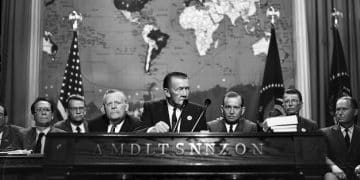US Involvement in International Aid: Risks & Rewards

US involvement in international aid programs carries potential risks such as misuse of funds and political entanglements, balanced against rewards like humanitarian assistance, global stability, and enhanced diplomatic relations.
Navigating the complexities of global engagement, the question “What Are the Potential Risks and Rewards of the US Involvement in International Aid Programs?” emerges as a crucial point of analysis for policymakers and citizens alike. Examining both the upsides and downsides provides a more complete picture of this contentious topic.
Understanding the Scope of US International Aid
The United States has historically been a major provider of international aid, offering assistance to countries facing economic hardship, natural disasters, and political instability. This aid takes various forms, including financial assistance, food aid, medical assistance, and technical support. Understanding the scope of these programs, as well as their intended goals, is essential for assessing their potential risks and rewards.
Types of US Aid Programs
US aid programs are diverse and tailored to meet specific needs. Here are a few prominent examples:
- Development Aid: Focused on long-term economic and social development, including education, healthcare, and infrastructure.
- Humanitarian Aid: Provides immediate relief during and after natural disasters or conflicts, encompassing food, water, shelter, and medical care.
- Security Assistance: Aims to bolster the stability of partner nations by providing military training, equipment, and financial support.
These programs are designed to address pressing global challenges, yet their effectiveness and impact often depend on complex geopolitical dynamics and local contexts.

The Potential Rewards of US Aid
US involvement in international aid programs can generate significant benefits, both for recipient countries and the United States itself. These rewards range from humanitarian gains to strategic advantages.
US aid often facilitates significant improvements in living conditions, health outcomes, and education levels in recipient countries. This humanitarian aspect is a central justification for providing aid and serves as an expression of American values.
Improved Global Health and Education
- Disease Eradication: US aid has played a vital role in combating infectious diseases, such as HIV/AIDS, malaria, and tuberculosis, contributing to global health security.
- Increased Educational Access: Investments in education systems have led to higher enrollment rates, improved literacy, and expanded opportunities for individuals in developing countries.
By promoting health and education, US aid programs help create more stable and prosperous societies.
In addition to the humanitarian aspects, US international aid can also promote global stability by helping countries develop stable economies and political systems. Instability can lead to conflict, displacement, and other issues that can spread across borders and affect the United States.
The Potential Risks of US Aid
Despite the potential rewards, US involvement in international aid programs is not without its risks. These risks can range from financial mismanagement to unintended political consequences.
One of the most persistent concerns is the potential for corruption and misuse of funds. When aid money is diverted or stolen, it fails to reach its intended beneficiaries, undermining the effectiveness of the program.
Corruption & Mismanagement
- Lack of Accountability: Insufficient oversight and accountability mechanisms can create opportunities for corruption.
- Political Instability: In some countries, aid money can be used to support corrupt regimes or exacerbate existing power struggles.
Addressing these risks requires greater transparency, stronger oversight mechanisms, and collaboration with local authorities.

Balancing Humanitarian Goals with Geopolitical Strategy
US foreign aid programs are often intertwined with geopolitical strategies, raising questions about whether humanitarian goals are sometimes secondary to political objectives. Finding the appropriate balance between these two aspects is vital for optimizing the effectiveness and integrity of aid initiatives.
The US government may use aid as a tool to pursue its foreign policy objectives, such as promoting democracy, countering terrorism, or securing access to resources. This can raise concerns about the impartiality and neutrality of aid.
Impact of Political Agendas
- Conditions on Aid: Aid may be conditioned on certain political or economic reforms, which can be perceived as interference in a country’s internal affairs.
- Strategic Alliances: Aid may be targeted at countries that are strategic allies of the United States, regardless of their development needs.
Striving for greater transparency, inclusivity, and a focus on recipient needs can foster more effective, ethically sound aid programs.
Balancing humanitarian goals with geopolitical strategies requires a clear commitment to transparency, accountability, and a focus on the needs of recipient countries. This means engaging local populations, respecting their cultures and values, and ensuring that aid programs align with their development priorities.
Examining the Economic Impact of US Aid
The economic impact of US aid is a subject of ongoing debate. While aid can stimulate economic growth and reduce poverty, it can also have unintended consequences, such as creating dependency or distorting local markets.
Aid can inject capital into developing economies, creating opportunities for investment, job creation, and infrastructure development. However, aid can also create a reliance on foreign assistance, hindering the development of local industries and markets.
Economic Effects of Aid Dependency
- Market Distortion: Aid can distort local markets by creating artificial demand or subsidizing certain industries, making it difficult for local businesses to compete.
- Dependency Culture: Over-reliance on aid can disincentivize governments from implementing sound economic policies and fostering self-sufficiency.
To maximize the positive economic impact of aid, it is crucial to promote local ownership, build local capacity, and foster sustainable development.
Fostering local ownership, building local capacity, and promoting sustainable development are all essential for maximizing the positive economic impact of foreign aid. This process involves working closely with local communities, supporting small businesses, and encouraging innovation.
Strategies for Maximizing Rewards and Minimizing Risks
To ensure that US international aid programs achieve their intended goals, it is crucial to implement strategies that maximize rewards and minimize risks. These strategies include strengthening oversight mechanisms, engaging local communities, and promoting transparency and accountability.
Strong oversight mechanisms are essential for preventing corruption and ensuring that aid money is used effectively. This includes regular audits, monitoring of projects, and enforcement of anti-corruption laws. Engaging local communities is also crucial, as they can provide valuable insights into the needs and priorities of the population.
Key Strategies for Enhanced Aid Programs
- Strengthen Oversight: Implement robust monitoring and evaluation systems to track the use of aid funds and measure the impact of programs.
- Engage Local Communities: Involve local communities in the planning and implementation of aid projects to ensure that they are aligned with local needs and priorities.
Promoting transparency and accountability is another critical strategy.
By ensuring transparency and accountability, strengthening oversight mechanisms, and engaging local communities, the US can maximize the rewards of its international aid programs while minimizing the risks.
Conclusion: Navigating the Future of US Aid Programs
The question of US involvement in international aid programs involves complex considerations, balancing the potential rewards with significant risks. As the US continues to engage in global development, it is essential to embrace strategies that promote transparency, accountability, and local ownership to maximize the positive impact of aid while minimizing potential pitfalls.
| Key Aspect | Brief Description |
|---|---|
| 🌍 Global Stability | Aid supports stable economies, reducing conflict and displacement risks. |
| 💰 Risk of Corruption | Funds may be misused or diverted, diminishing aid effectiveness. |
| 🩺 Improved Health & Education | Aid contributes to better healthcare and education in recipient nations. |
| 🤝 Geopolitical Influence | Aid can be used to strengthen alliances and advance US foreign policy goals. |
Frequently Asked Questions
▼
The main goals include providing humanitarian assistance, promoting economic development, fostering global health, and supporting US foreign policy objectives by aiding strategic allies and promoting stability.
▼
Corruption diverts funds away from intended beneficiaries, undermines project goals, and erodes trust in aid programs, thereby reducing their overall impact and creating inefficiencies in resource allocation.
▼
Implementing strong oversight mechanisms, promoting transparency and accountability, engaging local communities, and ensuring proper evaluation can improve resource management and program effectiveness.
▼
Engaging and empowering local communities and governments ensures that aid aligns with the needs and priorities of the recipients, thereby nurturing self-sufficiency and sustainability in the projects.
▼
Balancing involves making strategic decisions to support allies while addressing global humanitarian crises through careful allocation of resources, often leading to debates on whether to prioritize national interest or pure assistance.
Conclusion
As the US navigates its role in international aid, addressing the inherent risks while maximizing the potential rewards requires a balanced and thoughtful approach. By prioritizing transparency, accountability, and the needs of recipient communities, the US can enhance the effectiveness and impact of its aid programs, contributing to a more stable and prosperous world.





